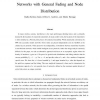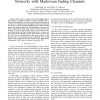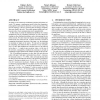914 search results - page 71 / 183 » Branch and Bound on the Network Model |
TCOM
2010
14 years 8 months ago
2010
Abstract— Today, due to the vast amount of literature on largescale wireless networks, we have a fair understanding of the asymptotic behavior of such networks. However, in real ...
MOBIHOC
2008
ACM
15 years 9 months ago
2008
ACM
Dealing with interference is one of the primary challenges to solve in the design of protocols for wireless ad-hoc networks. Most of the work in the literature assumes localized o...
CORR
2010
Springer
14 years 9 months ago
2010
Springer
In many wireless systems, interference is the main performance-limiting factor, and is primarily dictated by the locations of concurrent transmitters. In many earlier works, the l...
WIOPT
2011
IEEE
14 years 1 months ago
2011
IEEE
—Most work on wireless network throughput ignore the temporal correlation inherent to wireless channels, due to trouble with tractability. In order to better capture the temporal...
111
click to vote
PODC
2011
ACM
14 years 18 days ago
2011
ACM
We study several variants of coordinated consensus in dynamic networks. We assume a synchronous model, where the communication graph for each round is chosen by a worst-case adver...



